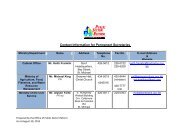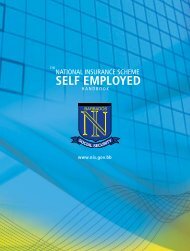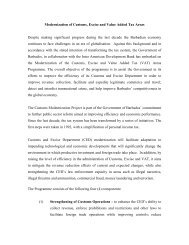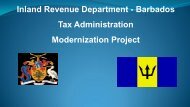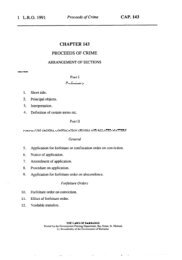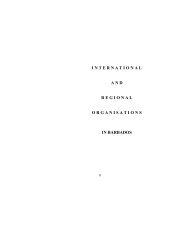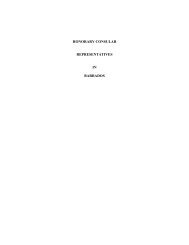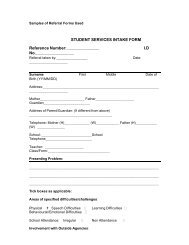Revised Central Bank-AMLA Guidelines - Anti-Money Laundering ...
Revised Central Bank-AMLA Guidelines - Anti-Money Laundering ...
Revised Central Bank-AMLA Guidelines - Anti-Money Laundering ...
You also want an ePaper? Increase the reach of your titles
YUMPU automatically turns print PDFs into web optimized ePapers that Google loves.
AML/CFT GUIDELINEISSUED BY THECENTRAL BANK OF BARBADOSIN CONJUNCTION WITH THE ANTI-MONEY LAUNDERING AUTHORITYMAY 2011confers responsibility for the supervision of financial institutions 2 to the Authority, which wasestablished in August 2000. A Financial Intelligence Unit has been established to carry out theAuthority’s supervisory function over financial institutions. As the operational arm of the Authority,its responsibilities, inter alia, include:i. Receiving suspicious or unusual transactions reports from financial institutions;ii. Investigating suspicious or unusual transactions reports;iii. Instructing financial institutions to take steps that would facilitate an investigation; andiv. Providing training to financial institutions in respect of record keeping obligations andreporting obligations under the MLFTA.Where a licensee is uncertain about how to treat an unusual or suspicious transaction, it is stronglyurged to speak directly to the FIU for preliminary guidance and then make a report as appropriate.Where the FIU believes on reasonable grounds that a transaction involves the proceeds of crime,the FIU will send a report for further investigation to the Commissioner of Police.The <strong>Bank</strong>, the supervisory and regulatory agency for institutions licensed under the FIA and IFSA,assesses these licensees’ AML/CFT framework and compliance with the MLFTA through periodiconsite inspections and on-going offsite monitoring. Where deficiencies are identified in policyframework or operations of the control framework for managing the licensee’s AML/CFTprogramme, the <strong>Bank</strong> will agree with the licensee on a time period to address the shortcomings.However, if the <strong>Bank</strong> is concerned by the seriousness of non-compliance and/or the lack ofresponsiveness to previous findings, the <strong>Bank</strong> may enforce its powers under Section 11(1)(d) ofthe FIA, Section 15(1)(c) of the IFSA; or Sections 33 to 36 of the MLFTA (See Section 37).In addition, the <strong>Bank</strong> is required by law to provide any information that it has in its possession,which the FIU deems useful for an investigation that is being conducted for the purposes of theMLFTA.From time to time, the <strong>Bank</strong>, in conjunction with the <strong>AMLA</strong>, will amend this Guideline but licenseesshould, as part of their risk management practices, stay current with emerging developments asthey relate to AML/CFT and upgrade their AML/CFT programme where necessary.6.0 THE ROLE OF THE BOARD AND SENIOR MANAGEMENTLicensees must see AML/CFT as part of their overall risk management strategy. <strong>Money</strong>laundering and terrorist financing expose a licensee to transaction, compliance and reputation risk.For financial institutions convicted of money laundering or terrorist financing, there areconsiderable costs. Therefore, licensees should establish an effective AML/CFT programme thatminimises these risks and potential costs.2 Offences and penalties under the MLFTA are set out in Appendix 3.<strong>Anti</strong>-<strong>Money</strong> <strong>Laundering</strong>/Combating Terrorist Financing Guideline May 2011 7<strong>Bank</strong> Supervision DepartmentCENTRAL BANK OF BARBADOS




